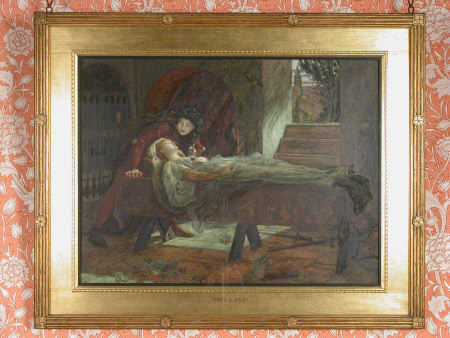The Tomb Scene from Shakespeare's 'Romeo and Juliet' (Act V: Scene III)
Lucy Madox Brown, Mrs William Michael Rossetti (1843 - 1894)
Category
Art / Drawings and watercolours
Date
1870 (monogrammed and dated)
Materials
Watercolour and gouache
Measurements
680 x 800 mm
Order this imageCollection
Wightwick Manor, West Midlands
NT 1288976
Caption
"Eyes, look your last! Arms, take your last embrace! And lips, O you, The doors of breath, seal with a righteous kiss A dateless bargain to engrossing death!"
Summary
Watercolour and gouache on paper in a gilt wood frame, The Tomb Scene from Shakespeare's 'Romeo and Juliet' by Lucy Madox Brown, Mrs William Michael Rossetti (1843 - 1894), signed with monogram and dated "70" [1870]. Juliet is lying on the tomb (Act V: Scene 3) with Romeo bending over her; the light falls on their faces through an open doorway disclosing a view of a church tower and trees.
Full description
In Act V, Scene III of Romeo and Juliet, Romeo enters Juliet's tomb intending to join her in death, unaware that she is in a drugged sleep. Challenged by Paris, Romeo fights and kills him: their swords are shown beneath the bier and the dead man can be seen lying on the far right. In Romeo's hand is the poison he is about to take. Following the moment shown in the painting, Juliet wakes to find Romeo dead and kills herself. The literary subject, careful depiction of the medieval setting and the details of the text, and the rich but subtle colouring can be seen in other late Pre-Raphaelite works. The strong composition, dominated by Juliet on the bier with the figures tightly enclosed in a restricted space (a device often used in Pre-Raphaelite art), is characteristic of Lucy's major works. The subject and treatment are dramatic rather than static. Romeo's face and awkward position bent low over Juliet convey the tragedy of the situation. Light and shadow are exploited for maximum dramatic effect: light from the door breaks through the gloom to highlight Juliet's face. The models for Romeo and Juliet were Lucy’s half-brother Oliver and sister Catherine. Lucy was largely taught by her father, Ford Madox Brown, and the tragic theme and composition of this painting appear to be related to his watercolour 'The Corsair's Return' (1870-71, Delaware Art Museum 1935-39) which he worked on while Lucy painted this picture. Both pictures have a strong horizontal emphasis provided by the full-length figure of an apparently dead girl in the foreground, although she lies right to left in Ford's picture. In both pictures the lover is silhouetted against arches on the far left, though Romeo bends over Juliet while Conrad looks across the room. Both scenes are also set in enclosed chambers, with the world outside glimpsed through a small opening to the right. The picture is in a 'Rossetti' frame. The Pre-Raphaelite artists took great care over the framing of their work, often designing or specifying special types of frame. Rossetti and his circle often used this type of frame made up of simple flat gilt sections ornamented with decorative discs of geometric patterns inspired by a variety of sources including Japanese porcelain and prints. Lucy Madox Brown created several pictures of young lovers from Shakespeare and worked on preparatory studies for Ferdinand and Miranda while this painting was exhibited in 1871 at the Dudley Gallery. 'Romeo and Juliet' is generally considered to be the finest of Lucy's few exhibited paintings and was well received. Tom Taylor, a critic for The Times, concluded that "with all its very obvious faults, this is a drawing of rare sentiment, and the execution, also, shows uncommon power and warrants high expectations of the young artist's future." Similar positive reviews appeared in The Athenaeum and The Academy.
Provenance
Lucy Madox Rossetti; their daughter, Helen Maria Rossetti, Mrs Gastone Angeli (b. 1879); formerly on loan from her daughter, Imogen, Mrs Dennis (d.1993); on loan from her daughter Helen Guglielmini; by whom given to National Trust in November 2001
Credit line
Wightwick Manor, The Mander Collection (National Trust)
Marks and inscriptions
LMB (monogram) 70 (signed and dated bottom right)
Makers and roles
Lucy Madox Brown, Mrs William Michael Rossetti (1843 - 1894) , artist
References
Brimacombe and Latham 2021: Dr Ruth Brimacombe and Abbie Latham (eds.), ‘Uncommon Power’: Lucy and Catherine Madox Brown (exh. cat.), Watts Gallery, 28 September 2021 – 20 February 2022, pp.20-21, 50-51 Taylor 1871: Tom Taylor, ‘The Dudley Gallery’, The Times, 26984, 11 February 1871, p.4 Anonymous 1871: ‘General Exhibition of Water-Colour Drawings’, The Athenaeum, 2258, 4 February 1971, p.148

